Not only are swords weapons, but they also very symbolic, and deeply ingrained in the human psyche. Over the centuries they have been used as symbols of power, used in countless types of ceremonies, as offerings, for coronations, as well as being used for trade. Over time, a number of swords have garnered their own legends and myths, linking the swords to famous events and people. Sometimes the swords themselves are the topic of legendary tales. In this article we’ll look at ten incredible swords from mankind’s history.
Joyeuse: The Legendary Sword of Charlemagne
The sword of Joyeuse, which is now housed in Frances Louvre Museum, is quite possibly one of the most iconic and famous swords in all of history. There are multiple historical records linking the sword to Charlemagne the Great, who reigned over 1200 years ago. The sword itself has been used in uncountable coronation ceremonies over the centuries, and is said have magical powers as well as having a rich legend and history.
The Seven-Branched Sword: Japanese Ceremonial Sword
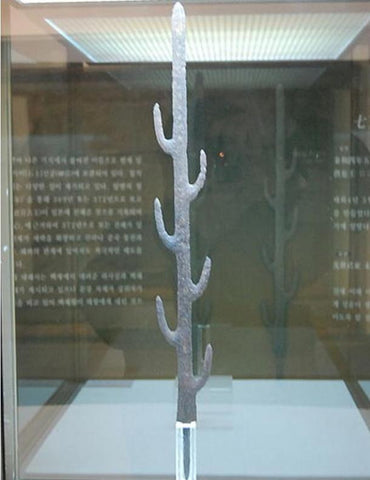
Nestled in the foothills of Tenri in Nara prefecture, Japan, is the Isonokami Shrine. The shrine which is thought to have been built in 4 AD is home to several Japanese national treasures, including the famous sword Nanatsusaya no Tachi, or ‘Seven-Branched Sword’. If you’re able to read the inscription on the blade, you’ll learn that the Seven-Branched Sword was gifted to the King of Wa, or ruler of Japan, by king of Baekje, which is believed to be an ancient kingdom in the south of Korea. The swords design indicates that it was never meant to be used as a weapon, but rather it was intended to be used as a ceremonial piece.
The Sword in the Stone of San Galgano
If you ever find yourself in Tuscany, Italy, take the time to travel to the top of Montesiepi, where you’ll find a rather pleasant round chapel. Located in the chapel, inside a glass case you’ll see a 12th century sword lodged within a piece of solid rock. According to legend, the sword was thrust into the stone by San Galgano, a knight and local nobleman. The legend says San Galgano was out for a walk when he had a vision of Jesus, Mary and Twelve Apostles. A voice instructed San Galgano to renounce all his worldly possessions. San Galgano replied to the voice saying that giving everything up would be as easy as splitting a stone with his sword, to emphasis the point he drew his sword and thrust it into the stone. To his understandable amazement, the sword went through the stone like a hot wire through margarine, and has been stuck there ever since, allegedly.
Goujian: The Time Defying Chinese Sword
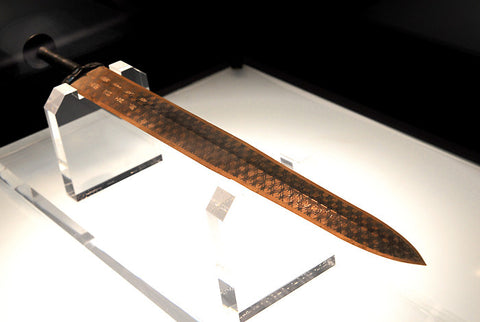
Over fifty years ago, a team of archaeologists uncovered a unusual and rare sword in a Chinese tomb. Despite the sword being over 2,000 years old, the sword seemed to have completely escaped the elements and was rust free. Additionally, the sword was able to draw blood when one of the archaeologists decided to test its sharpness on his finger, despite being a bit stupid, it seemed to prove the sword had managed to survive the ravages of time unaffected. Furthermore, the craftsmanship was incredibly detailed for a sword of this time, and was something of an oddity for the period. The sword is considered a national treasure, and was probably once owned by the Emperor Goujian of Yue.
The Cursed Muramasa Samurai Swords
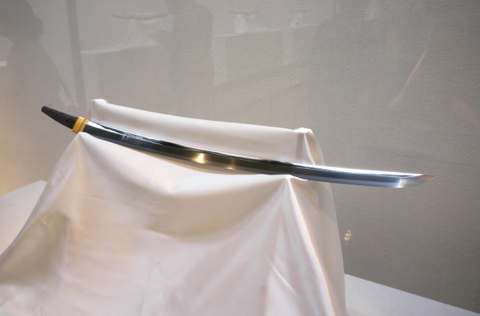
During the Muromachi period in Japan (14th – 16th Century), there lived a swordsmith named Muramasa Sengo. By all accounts he was exceptionally skilled, but also slightly unhinged, and prone to bouts of violence. The legend states that his destructive nature was passed into the swords he forged. The resulting blades would then be capable of possessing their new owners, which in turn would cause the wielder to become rage filled, unhinged warriors, just like the swordsmith who forged them.
Regardless of the dodgy reputation of the swords forged by Muramasa, they were undeniably created by a skilled swordsmith, and therefor proved to be popular in Japan. That was until Edo period, when the first Shoguns father and grandfather where both murdered by their retainers, who fate would have it, both wielded Muramasa blades. So it came to be that the Muramasa blades where thought to hold a curse against the Tokugawa family, resulting in the blades being banned by the Shogun. Just a small number of the blades survived until modern times and they are now considered priceless treasures.
Ulfberht Viking Swords

During the last century, just over 170 Viking Ulfberht swords have been uncovered in and around Europe, dating from approximately 800 – 1000 AD. The sword were incredibly well crafted, and made of metals so pure, that many experts have stated that they were centuries ahead of their time. The Ulfberht swords where made with crucible steel, which contains carbon which was three times higher than any other steel at the time. It was believed that the technology and methods to create this sort of steel was not invented until the Industrial Revolution.
It was originally believed that the swords may have originated from Asia or the Middle East, but modern research has identified that the materials used came from central Europe. It is entirely possible, that the methods and knowledge required to forge these swords came from outwith Europe. Interestingly, the Volga trade routes linking the Vikings and the Middle East opened at the same time the first Ulfberht swords appeared, the last of which was produced around the time the trade routes closed.
Ivan the Terrible’s Sword
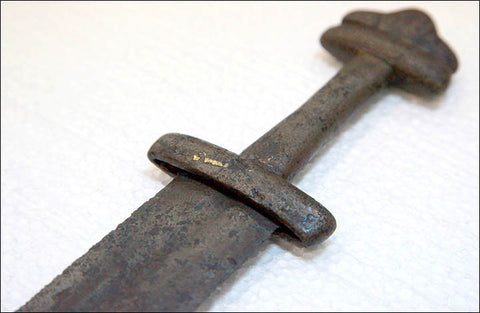
In 1975, archaeologists in Siberia unearthed a inexplicable medieval sword which appears to have been forged in Germany and decorated in Sweden. The archaeologists where perplexed as to how a 12th century sword created in Europe came to be unearthed from the banks of the River Om in starkly remote Novosibirsk region. Lengthy research and investigations has led to the theory that sword may have once belonged to Tsar Ivan the Terrible, which was given to him as a gift, which was then used in battle ahead of the conquest of Siberia.
Chinese Votive Sword in North America
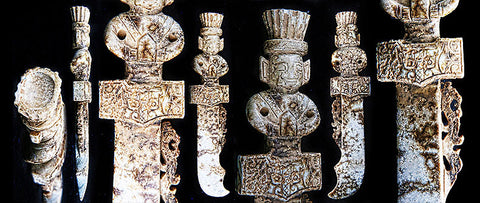
In the summer of 2014, an unusual discovery was made on the shore of a small stream in Georgia, USA. An intricately detailed Chinese votive sword which was fashioned in Lizardite. The sword was carved with several symbols, including the face mask of the Taotie and a Dragon, which are more commonly found on jade objects from the Xia and Zhou Dynasty periods (1600 – 256 BC). This sword gives weight to the theory that Chinese discovered and travelled to North America thousands of years before Christopher Columbus.
Masterfully Forged Indian Sword

The master swordsmiths behind some of India’s incredible swords was not fully appreciated until scientists from Italy and the UK came together to study the Shamsheer swords. The original design for these swords originated from Persia, where it spread across Asia and eventually evolved into the family of swords now known as Scimitars. The scientists where able to highlight that the steel used in these swords was impressible pure. The carbon content of the swords was around one percent, making the swords stronger and able to keep an edge longer. This type of steel is commonly used in high end swords or other prestige items.
Durandal: Sword of Roland
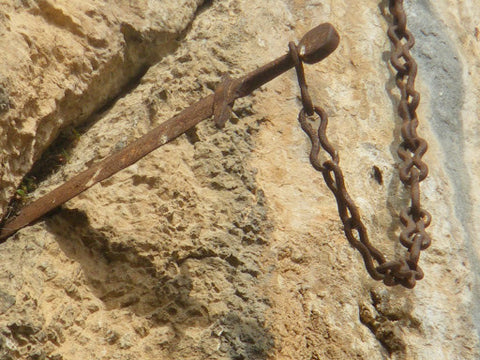
Embedded in the face of a rock in Rocamadour, which is a site roughly 160km North of Toulouse, is an iron sword surrounded in legend and myth. According to local tales, the sword, named Durandal, had been gifted to Roland, who was a famous figure, popular in medieval tales. Roland was considered to be a formidable warrior, being called the best warrior of the emperors court. One of the stories surrounding Roland is the tale of his last stand battle, the Battle of Roncevaux, which was an actual historical battle, but was later embellished to improve the story.
The legend states that Rolands sword was said have fantastical powers, so much so that during the last stand battle, Roland tried to destroy the blade before it fall into the hands of enemy. It is alleged that Roland flung Durandal high in the air, where as it descended it wedged itself in the rock in Rocamadour, where to this day it remains.
source https://www.bladespro.co.uk/blogs/news/10-legendary-swords-from-the-ancient-world

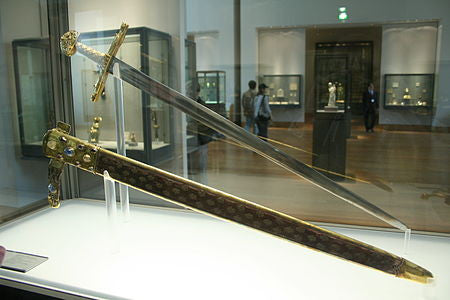

No comments:
Post a Comment